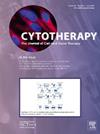Good Manufacturing Practice-grade fibronectin for hollow-fiber bioreactor cell manufacture: a mesenchymal stromal cell case study
IF 3.7
3区 医学
Q2 BIOTECHNOLOGY & APPLIED MICROBIOLOGY
引用次数: 0
Abstract
Background aims
The need for large-scale production of mesenchymal stromal cell (MSC)-based cellular therapeutics continues to grow around the globe. Manual cell expansion processes can be highly variable between operators, require significant hands-on time from skilled staff and, because of the large number of open manipulation steps required to produce cells in dose-relevant quantities, be prone to greater risk of contamination relative to automated processes. All of these can increase overall production costs and risks to the patient. In order to meet the needs of this growing industry, viable options for large-scale automation coupled with consistent and compliant ancillary materials needed to drive cell expansion are needed.
Methods
In the work described herein, the automated and functionally closed hollow-fiber bioreactor system Quantum Flex (Terumo Blood and Cell Technologies, Inc., Lakewood, CO, USA) was used in conjunction with Good Manufacturing Practice (GMP)-compliant, virus-inactivated human fibronectin (FN) from Akron Bio (Boca Raton, FL, USA) to expand MSCs to clinically relevant numbers. In order to assess the performance of Akron Bio's GMP-grade FN, use of this product in the production of MSCs was referenced against use of a research-use-only (RUO)-grade FN product used extensively for MSC expansion in Quantum. Because many MSC-based processes require passaging of cells to attain the appropriate number of cells needed, a two-passage process was employed comparing the transfer of MSCs expanded on RUO FN to RUO FN, GMP FN to GMP FN and RUO FN to GMP FN to assess the impacts of transitioning from one grade of FN to another, as a product might be required to do as it moves from pre-clinical to clinical stages and beyond.
Results
No statistically significant differences were noted when MSCs were transferred from RUO FN to RUO FN, GMP FN to GMP FN or RUO FN to GMP FN in terms of harvest yield, population doubling time, seeding efficiency estimates or fold expansion. All MSCs harvested from all groups met International Society for Cell & Gene Therapy standards for MSCs in terms of protein marker expression measured by flow cytometry, adherence to plastic, downstream cell morphology and trilineage differentiation.
Conclusions
The combination of Quantum Flex as an expansion platform and Akron Bio's GMP FN is seen as an attractive option for larger-scale manufacture of GMP-grade MSC products.
用于中空纤维生物反应器细胞制造的优良生产规范级纤维连接蛋白:间充质间质细胞案例研究。
背景目的:大规模生产基于间充质基质细胞(MSC)的细胞疗法的需求在全球范围内持续增长。手动细胞扩增过程在操作人员之间可能有很大的差异,需要熟练的工作人员大量的动手时间,并且由于生产剂量相关数量的细胞需要大量的开放操作步骤,相对于自动化过程容易产生更大的污染风险。所有这些都会增加总体生产成本和患者的风险。为了满足这个不断增长的行业的需求,需要大规模自动化的可行选择,以及驱动细胞扩展所需的一致和合规的辅助材料。方法:在本文所述的工作中,自动化和功能封闭的中空纤维生物反应器系统Quantum Flex (Terumo Blood and Cell Technologies, Inc., Lakewood, CO, USA)与来自Akron Bio (Boca Raton, FL, USA)的符合良好生产规范(GMP)的病毒灭活人纤维连接蛋白(FN)一起使用,以扩增MSCs至临床相关数量。为了评估Akron Bio的gmp级FN的性能,将该产品在MSC生产中的使用与在Quantum中广泛用于MSC扩展的研究用(RUO)级FN产品的使用进行了比较。由于许多基于msc的过程需要传代细胞以获得所需的适当数量的细胞,因此采用双传代过程来比较从RUO FN扩展到RUO FN, GMP FN到GMP FN以及RUO FN到GMP FN的MSCs转移,以评估从一个级别的FN过渡到另一个级别的影响,因为产品可能需要从临床前阶段过渡到临床阶段并超越临床阶段。结果:MSCs从RUO FN转移到RUO FN、GMP FN转移到GMP FN或RUO FN转移到GMP FN在收获产量、群体倍增时间、播种效率估计或倍增倍数方面均无统计学差异。从所有组中收获的所有MSCs都符合国际细胞与基因治疗协会关于MSCs的标准,包括流式细胞术测量的蛋白质标记表达、与塑料的粘附、下游细胞形态和三龄分化。结论:Quantum Flex作为扩展平台与Akron Bio的GMP FN相结合,被视为大规模生产GMP级MSC产品的一个有吸引力的选择。
本文章由计算机程序翻译,如有差异,请以英文原文为准。
求助全文
约1分钟内获得全文
求助全文
来源期刊

Cytotherapy
医学-生物工程与应用微生物
CiteScore
6.30
自引率
4.40%
发文量
683
审稿时长
49 days
期刊介绍:
The journal brings readers the latest developments in the fast moving field of cellular therapy in man. This includes cell therapy for cancer, immune disorders, inherited diseases, tissue repair and regenerative medicine. The journal covers the science, translational development and treatment with variety of cell types including hematopoietic stem cells, immune cells (dendritic cells, NK, cells, T cells, antigen presenting cells) mesenchymal stromal cells, adipose cells, nerve, muscle, vascular and endothelial cells, and induced pluripotential stem cells. We also welcome manuscripts on subcellular derivatives such as exosomes. A specific focus is on translational research that brings cell therapy to the clinic. Cytotherapy publishes original papers, reviews, position papers editorials, commentaries and letters to the editor. We welcome "Protocols in Cytotherapy" bringing standard operating procedure for production specific cell types for clinical use within the reach of the readership.
 求助内容:
求助内容: 应助结果提醒方式:
应助结果提醒方式:


